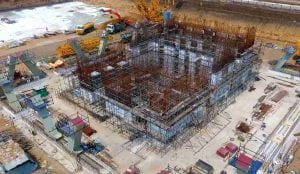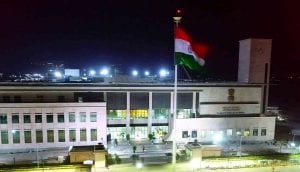
Minister hints at discarding Amaravati project over ‘unsafe location’

Ever since the change of guard in Andhra Pradesh following the April 11 Assembly elections, a question mark has been hanging over the fate of Amaravati, the dream capital city project envisioned by former Chief Minister N Chandrababu Naidu.
The first clear indication of the Jagan Mohan Reddy government’s plan to discard the project came on Wednesday (August 21), when the State Municipal Administration Minister Botsa Satyanarayana said that Amaravati was not a “safe location” because the region was “flood-prone”.
Pointing out that large parts of the Vijayawada-Guntur region in the coastal belt, where the ultramodern, ₹58,000 crore capital city was planned, were flooded by the recent heavy rains, the Minister said that the construction cost in Amaravati was much higher as compared to other regions.
“If you have to invest one lakh rupees elsewhere, here you have to spend two lakh rupees. We will review and take a decision,” Satyanarayana said.
The Minister’s observations came in the backdrop of the YSRCP government’s decision to put on hold all construction activities related to the capital project till it is “reviewed at the highest level.”
Also Read: Chandrababu Naidu’s Capital failures
Political slugfest

By invoking the flood threat to the capital region, the Minister has triggered a fresh round of political war of words between the ruling YSR Congress and the TDP.
Incidentally, the National Green Tribunal (NGT) had approved the project in 2016 after thoroughly examining the issues pertaining to environmental impact, including the vulnerability of the region to seasonal floods.
“It is amply clear that the Andhra Pradesh government is taking appropriate and adequate steps for sustainable development while executing the capital city project,” the NGT had said in its order and rejected petitions by a clutch of NGOs seeking quashing of environmental clearance.
The Tribunal also made it clear that the flood-prone areas mentioned in the petitions were outside the capital city region.
The TDP lambasted the government for resorting to ‘scare-mongering’ to camouflage its real political intentions.
Dubbing Satyanarayana’s remarks as “irresponsible” and “baseless”, it said, “Amaravati was selected because of its potential in terms of abundance of land and other natural resources at its disposal and its location.”
Also Read: The fate of AP’s ₹55,000 cr dream project, Amaravati, hangs in balance
“Building a capital of any magnitude requires investment in terms of finances, land and people. To write off a city citing high cost goes to show the lack of interest and commitment of the state government to build Amaravati. This is a legacy that the YSRCP is keen to discontinue, depriving the Telugu people of a capital they can call their own,” the party said in a statement.
However, the ruling party pointed out that an expert committee, headed by former Urban Development Secretary KC Sivaramakrishnan, had rejected Amaravati as an option because it is located in the flood-prone zone.

“But (former CM) Chandrababu Naidu, ignoring the advice, plumped for Amaravati. The recent floods have vindicated the Sivaramakrishnan committee’s position,” said YSRCP MLA A Ramakrishna Reddy.
The five-member committee, appointed by the UPA government in 2014, had suggested nearly six options covering a string of small cities that could be developed as industrial, business and investment hubs.
The committee, which submitted its report to the Union Home Ministry in August, 2014, favoured decentralised development of a cluster of towns, covering the coastal and Rayalaseema regions, instead of replicating the Hyderabad model.
Also Read: Biz-friendly yesterday, Andhra Pradesh scaring off investors today
However, the committee’s views ran contrary to the stated position of Chandrababu Naidu, who envisioned the new capital city on the Vijayawada-Guntur stretch in the prosperous coastal region because of its locational advantage, fully developed infrastructure, air quality, rail and road connectivity and strong backing by powerful political and industrial lobby.
The expert committee had opposed the location as it would involve acquisition of a vast stretch of fertile agriculture land, threatening food security in the long run.
Not our domain
The Union Minister of State for Home Affairs, G Kishan Reddy, told The Federal that the Centre would not take any decision on the changing of Andhra Pradesh capital since the matter was not in its purview.
“There is a need for a debate among the people of Andhra. The central government has no role in it,” he said.
Soon after coming to power with a landslide mandate, Jagan had termed Amaravati as a “huge scam and a case of insider trading” where a number of senior TDP leaders had benefited. He ordered all civil works to stop in Amaravati and this led to the real estate sector crashing in the state capital. An acre of land that earlier used to cost between ₹1.5 to 2 crore depending on the location, is now available for one-fourth the amount.
Also Read: Naidu proposes, Jagan disposes: How Amaravati landed in hot water
Functional capital
According to official sources, the new government is keen on ‘scaling down’ the scope of the capital project by making Amaravati a ‘functional capital’ with administrative headquarters while a ‘cluster of hubs’ will be developed across the state — north coastal, south coastal and Rayalaseema regions.
A series of recent developments has compounded fears over the fate of the capital project. Last month, the World Bank dropped the ₹2,000 crore loan proposal to finance the proposed Amaravati Sustainable Infrastructure and Institutional Development Project.
The civil society groups like the National Alliance of People’s Movements (NAPM) and the Working Group on International Financial Institutions welcomed the withdrawal of the loan proposal. They had alleged that the project would damage the floodplains of river Krishna, fertile farmlands and forests, displacing around 20,000 families.
In its latest Budget, the State government earmarked a mere ₹500 crore for Amaravati, signalling that the project is not on its radar.
If the project is eventually shelved or scaled down, the worst-affected would be the farmers who gave 34,000 acres of land under land pooling for the dream capital, with high expectation that it would transform the region.


